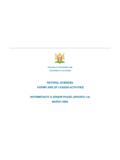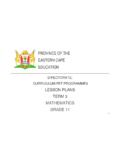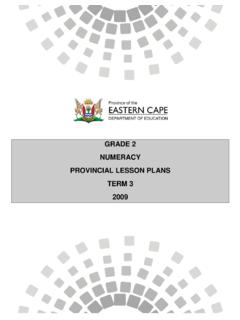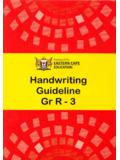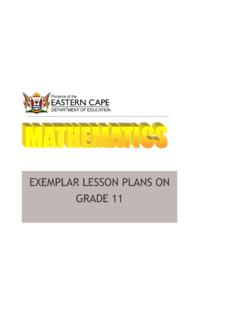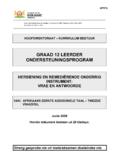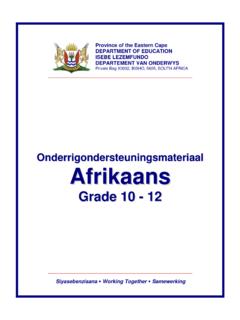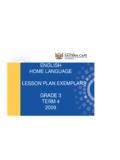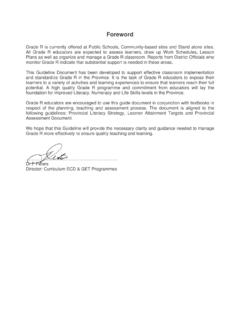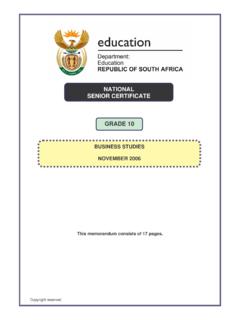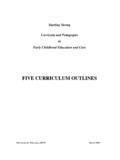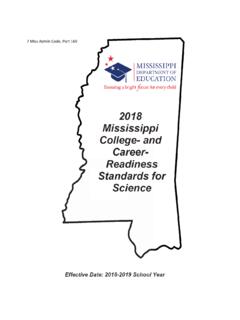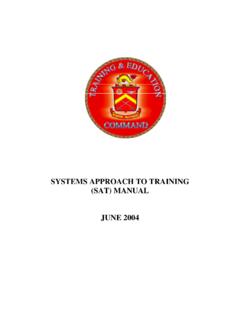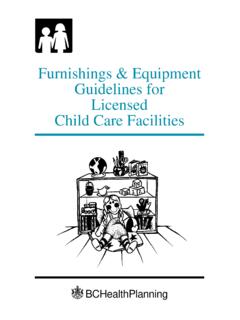Transcription of Gr 2 Term 1 2019 Maths Lesson Plan - Curriculum
1 GRADE 2. Mathematics Teacher Toolkit: CAPS Aligned Lesson Plans TERM 1. ii Grade 2 Mathematics A MESSAGE FROM THE NECT. NATIONAL EDUCATION COLLABORATION TRUST (NECT). Dear Teachers This learning programme and training is provided by the National Education Collaboration Trust (NECT) on behalf of the Department of Basic Education (DBE)! We hope that this programme provides you with additional skills, methodologies and content knowledge that you can use to teach your learners more effectively. What is NECT? In 2012 our government launched the National Development plan (NDP) as a way to eliminate poverty and reduce inequality by the year 2030. Improving education is an important goal in the NDP which states that 90% of learners will pass Maths , Science and languages with at least 50% by 2030. This is a very ambitious goal for the DBE to achieve on its own, so the NECT was established in 2015 to assist in improving education. The NECT has successfully brought together groups of people interested in education so that we can work collaboratively to improve education.
2 These groups include the teacher unions, businesses, religious groups, trusts, foundations and NGOs. What are the learning programmes? One of the programmes that the NECT implements on behalf of the DBE is the District Development Programme'. This programme works directly with district officials, principals, teachers, parents and learners; you are all part of this programme! The programme began in 2015 with a small group of schools called the Fresh Start Schools (FSS). The FSS helped the DBE. trial the NECT Maths , Science and language learning programmes so that they could be improved and used by many more teachers. NECT has already begun this scale-up process in its Provincialisation Programme. The FSS teachers remain part of the programme, and we encourage them to mentor and share their experience with other teachers. Teachers with more experience using the learning programmes will deepen their knowledge and understanding, while some teachers will be experiencing the learning programmes for the first time.
3 Let's work together constructively in the spirit of collaboration so that we can help South Africa eliminate poverty and improve education! Teacher Toolkit: CAPS Aligned Lesson Plans Term 1 iii iv Grade 2 Mathematics CONTENTS. About the Lesson Plans and Resources_____ 3. Lesson plan Outline_____ 6. Week 1 Revision Lesson Activities_____ 9. Week 2_____ 18. Lesson 1: Numbers up to 20_____ 18. Lesson 2: Numbers 11 to 20_____ 21. Lesson 3: Numbers 1 to 20 (place value)_____ 24. Lesson 4: Numbers 1 to 25 (place value)_____ 27. Week 3_____ 30. Lesson 5: Numbers 20 to 25 (place value)_____ 30. Lesson 6: Length_____ 33. Lesson 7: Length_____ 36. Lesson 8: Counting on and back: addition and subtraction_____ 39. Week 4_____ 42. Lesson 9: Number bonds and family facts to 20_____ 42. Lesson 10: Building up and breaking down numbers_____ 45. Lesson 11: Addition doubles: 1 to 20_____ 48. Lesson 12: Near doubles_____ 51. Week 5_____ 54. Lesson 13: Mass starting to understand kilograms_____ 54.
4 Lesson 14: Building through 10 and working in tens_____ 57. Lesson 15: Tens and counting in tens_____ 60. Lesson 16: Tens arrays_____ 63. Week 6_____ 66. Lesson 17: Tens sharing and grouping_____ 66. Lesson 18: Number patterns: 10_____ 69. Lesson 19: Patterns of 10_____ 72. Lesson 20: Geometric patterns_____ 75. Week 7_____ 78. Lesson 21: Geometric patterns_____ 78. Lesson 22: Data_____ 81. Lesson 23: Data_____ 84. Lesson 24: Data_____ 87. Teacher Toolkit: CAPS Aligned Lesson Plans Term 1 1. Week 8_____ 90. Lesson 25: 3-D objects_____ 90. Lesson 26: Building with 3-D objects_____ 93. Lesson 27: Fives and counting in fives_____ 96. Lesson 28: Fives arrays_____ 99. Week 9_____ 102. Lesson 29: Fives sharing and grouping_____ 102. Lesson 30: Number patters: 5_____ 105. Lesson 31: Patterns of five_____ 108. Lesson 32: Money_____ 111. Week 10_____ 114. Lesson 33: Money_____ 114. Lesson 34: Twos and counting in twos_____ 117. Lesson 35: Twos arrays_____ 120.
5 Lesson 36: Twos sharing and grouping_____ 123. Week 11_____ 126. Lesson 37: Number patterns: twos_____ 126. Lesson 38: Patterns of two_____ 129. Lesson 39: Time_____ 132. Lesson 40: Time Calendars_____ 135. 2 Grade 2 Mathematics ABOUT THE Lesson PLANS. AND RESOURCES. The Lesson plans and resources in this book are part of Links are given in the lessons to all appropriate DBE. the Teacher Toolkit for Mathematics Grade 2 Term 1. worksheets. Note that the pages referred to are all The other documents in the toolkit are: from the 2017 edition of the DBE workbook. This a CAPS aligned Planner, Tracker and Assessment changes very little from year to year, but if you use a Resources different edition of the workbook, you should check that the worksheet on the same page in this different A variety of printable resources that you can copy edition is still appropriate for your purpose. for yourself and/or your learners are included at the end of the Lesson plans in this book.
6 They include: Bilingual learner material is provided in the LoLT of a) Resource sheets: These comprise a variety of the school in accordance with the Foundation Phase teaching and learning aids that are needed in language policy. certain lessons. The specific resource sheet, and the number of copies needed, is noted in the 3. Broad overview of the content of the relevant Lesson plan and in the tracker so that you Lesson plans can prepare them in advance. b) Mental mathematics challenge cards: A pack Each Lesson plan provides a set of steps to guide of eight mental mathematics challenge cards you in delivering the Lesson . In addition, it contains (solutions are provided) are included to allow for learner activities that will help learners develop the routine weekly mental mathematics activities that concepts and skills set for the Lesson . These include you can record. the required daily mental mathematics activity, whole c) Enrichment activity cards: A pack of 32 class oral activities led by the teacher, classwork and enrichment activity cards (solutions are provided) homework activities, as well as answers for these.
7 All are included for learners who complete the day's the classwork and homework activities are given in the classwork activities ahead of the class. Lesson plans, learners must either copy these into their books or teachers can photocopy the activity. A. About the Lesson plans The Lesson plans give detailed information about 4. Assessment how to teach a CAPS-aligned Lesson every day. By The programme of assessment suggested in the Lesson following the Lesson plans, you will ensure that you plans and tracker is adaptable and can be adjusted cover the content and assessment tasks specified to comply with the CAPS as amended by Circular S1. in the Curriculum and give your learners the best of 2017 and provincial responses to this. The Lesson possible chance of developing the knowledge and plans and tracker provide a number of resources to skills required for Mathematics in this grade. support both formal and informal assessment in this 1. Curriculum alignment programme, as noted below: Oral and practical activities which you can The lessons are sequenced according to the topics in use to assess learners as you observe and the CAPS and weighted according to requirements interact with them in class are provided in the given there, and the programme of assessment tracker.
8 Rubrics and checklists with criteria for is accommodated. Every Lesson shows the CAPS. this assessment are provided in the tracker, at content and skill being focussed on in the Lesson . the end of the table for the week in which the assessment is suggested. 2. Links to the DBE workbooks There is an item bank of written assessment Teacher Toolkit: CAPS Aligned Lesson Plans Term 1 3. questions, with marking memos in the tracker. 6. Sequence adherence and pacing Items that are relevant to a specific Lesson are noted in the resources column for the Lesson in Each Lesson and its contents have been carefully the tracker. sequenced. It is therefore important that lessons are A complete overview of the programme of not skipped. Should you miss a Mathematics Lesson assessment for the term is given in the tracker. for any reason, you should continue the next day from This shows you when it is suggested you carry where you last left off. Do not leave a Lesson out.
9 You out both formal (and informal) assessment may need to speed up the pace of delivery to catch tasks which are oral, practical and written. This up a missed Lesson by covering the Lesson concept will assist you in planning and monitoring your content of two consecutive days in one day. To do this assessment programme. you could cut out or cut back on some of the routine There is also a recommended mark record activities like mental mathematics or homework sheet in the tracker. This has been drawn up to reflection to save time until you are back on track assist you as you record your marks on with the expected delivery of the plans. You need to SA-SAMS. prepare very well as this will help you to manage the full set of lessons at the appropriate pace. 5. Managing the Lesson programme 7. Lesson preparation A set of orientation activities on eight different The Lesson plans provide a detailed Lesson design topics aligned with the CAPS baseline assessment for you to follow.
10 However, to deliver the lessons requirements is provided for the start of the term. You successfully you must do the necessary preparation should use all or a selection of these activities in the yourself. The information below outlines some key first week of term before the formal teaching of the aspects of preparation. numbered Lesson plans begins. a) Term focus: Start by looking at the CAPS. document and orientating yourself to the CAPS. The formal Curriculum for Term 1 of Grade 2 is covered content focus for the term. It is important that in a set of 40 numbered, fully developed Lesson plans, you are clear about the content focus, as this will paced to cover a 50-day teaching term. There are four frame everything you do in your Mathematics such Lesson plans each week for ten weeks of the term. lessons during the term. There is no formal numbered Lesson plan for the fifth b) Prepare resources: The resources needed for Lesson each week; instead, it is assigned for you to use each Lesson are listed in each Lesson plan and for a variety of purposes.
